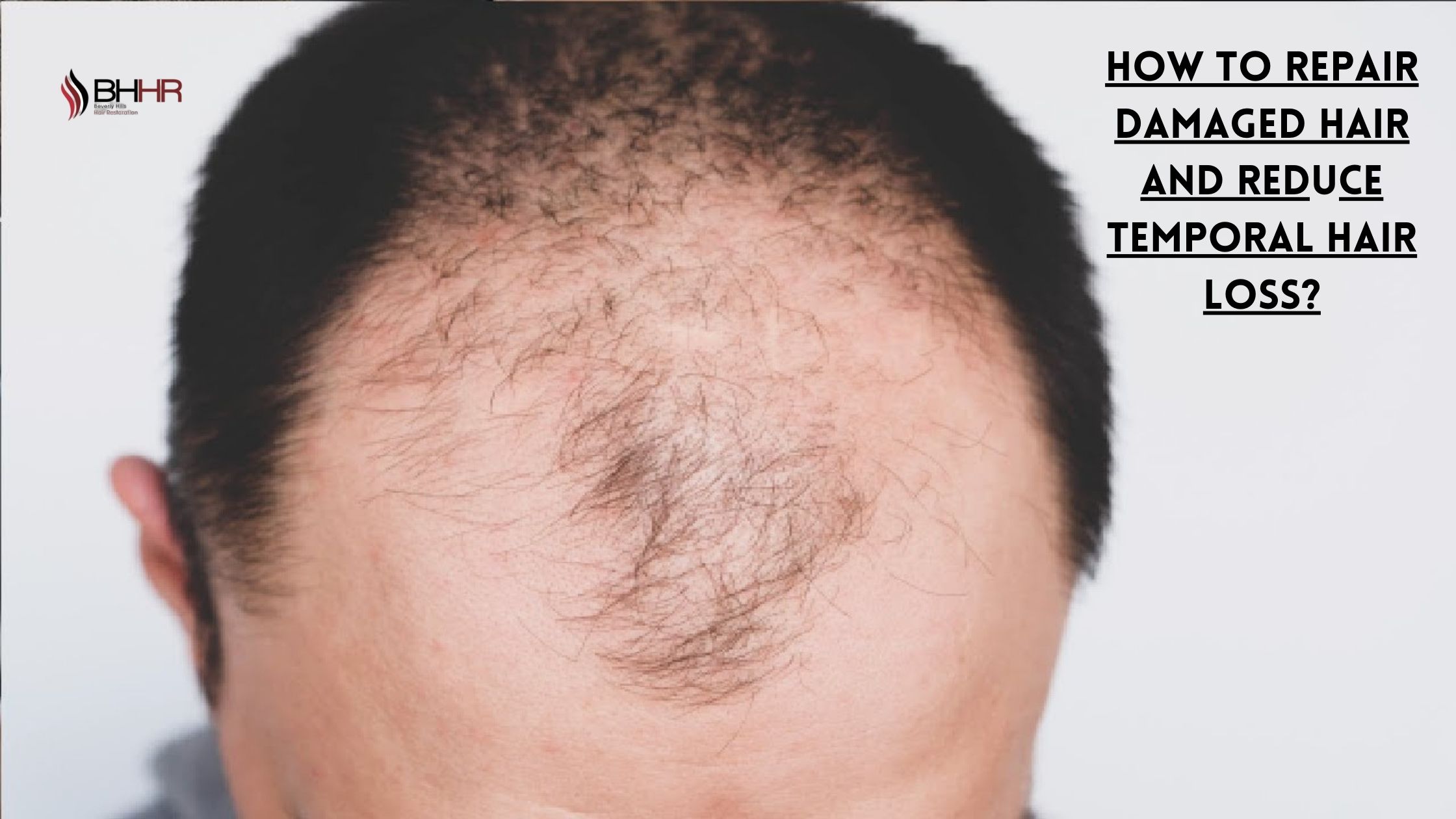Hair damage and temporal hair loss are common concerns for many individuals. Whether caused by genetics, excessive styling, or poor hair care habits, these issues can affect confidence and overall appearance. The positive aspect is that hair that has been damaged can be fixed, and there are efficient ways to minimize temporary hair loss. Reviving vibrant, healthy hair can be facilitated by determining the root problems & using the right remedies. This guide will examine the most effective strategies to mend damaged hair while avoiding additional hair loss.
Common Causes of Temporal Hair Loss and Hair Damage
Genetic and Hormonal Factors
Genetics play a significant role in temporal hair loss, making individuals with a family history of baldness more susceptible to hair thinning at the temples. In addition, hair follicles may decrease in size due to hormonal disturbances, particularly excess dihydrotestosterone (DHT), that over time lead to thinning and weaker hair.
Excessive Heat Styling and Chemical Treatments
Regular utilization of heat styling devices such as straighteners, curling wands, and blow dryers can compromise hair integrity, resulting in breakage and split ends. Chemical treatments such as hair coloring, perms & relaxers can further strip hair of its natural moisture, causing dryness and increased shedding. These factors can contribute to both hair damage and temporal hair loss.
Poor Diet and Nutritional Deficiencies
A deficiency in crucial nutrients can greatly affect the health of hair. Deficiencies in biotin, iron, zinc, and vitamin D can lead to weakened hair follicles, slowing down growth and making hair more prone to shedding. A well-balanced diet is crucial to maintaining strong, healthy hair.
Stress and Lifestyle Factors
Elevated stress levels can lead to hair loss, especially a condition referred to as telogen effluvium, in which hair enters the shedding phase too early. Additionally, poor sleep, smoking, and excessive alcohol consumption can weaken hair follicles, making temporal hair loss more prominent.
Effective Ways to Repair Damaged Hair
Use Nourishing Hair Treatments
To repair damaged hair, it’s essential to incorporate deep conditioning treatments, hair masks, and protein-infused products. Ingredients such as keratin, argan oil, and shea butter can help restore moisture and strengthen hair fibers.
Choose Sulfate-Free and Gentle Hair Products
Harsh shampoos that contain sulfates and parabens can remove the natural oils from hair, resulting in dryness and breakage. Opting for sulfate-free, nourishing shampoos and conditioners can help maintain hydration and protect hair from further damage.
Avoid Excessive Heat and Chemical Treatments
Reducing the use of heat styling devices and chemical processes can help avoid additional harm. If heat styling is necessary, applying a heat protectant spray can help reduce harm to the hair cuticle.
Trim Split Ends Regularly
Regular trims help remove split ends, preventing further damage from traveling up the hair shaft. This simple step can improve hair appearance and promote healthier growth.
Protect Hair from Environmental Damage
Wearing hats or scarves can shield hair from harsh weather conditions and UV exposure. Additionally, using protective serums or leave-in conditioners can create a barrier against pollution and humidity.
How to Reduce Temporal Hair Loss Naturally
Improve Scalp Health
Keeping a clean and healthy scalp is crucial for minimizing temporary hair loss. Regular scalp exfoliation, massaging, and proper hydration can help stimulate hair growth and reduce buildup that may block hair follicles.
Eat a Nutrient-Rich Diet
Consuming a balanced diet rich in protein, omega-3 fatty acids, and essential vitamins can support hair growth and prevent thinning. Foods such as salmon, eggs, spinach, and nuts are excellent choices for promoting healthy hair.
Use Essential Oils for Hair Growth
Natural oils like rosemary, peppermint, and castor oil have been shown to improve hair thickness and stimulate hair follicles. Regular scalp massages with these oils can enhance blood circulation and reduce temporal hair loss.
Reduce Stress and Improve Sleep Quality
Stress relief methods, like meditation, yoga, and deep breathing exercises, can assist in minimizing hair loss. Furthermore, obtaining 7-8 hours of restful sleep every night enables the body to repair and regenerate hair cells.
Adopt a Gentle Hair Care Routine
Avoiding tight hairstyles, rough towel drying, and over-washing can help protect hair from unnecessary stress and breakage. Utilizing a silk pillowcase can additionally decrease friction and lessen hair damage.
Medical and Professional Treatments for Hair Repair
Hair Transplant as a Long-Term Solution
For severe cases of temporal hair loss, a hair transplant can provide permanent results. This process entails transferring healthy hair follicles from a donor site to the receding temples, rejuvenating a naturally appearing hairline.
Consulting a Dermatologist or Hair Specialist
If hair loss continues even after trying home treatments, seeking advice from a professional can assist in identifying the root cause and suggesting effective remedies.
Conclusion
Restoring damaged hair and decreasing temporary hair loss necessitates a blend of appropriate hair care, a nutritious diet, stress management, and, in certain instances, professional interventions. By making simple lifestyle adjustments and using targeted hair treatments, individuals can strengthen their hair and promote regrowth. For those seeking advanced solutions, Beverly Hills Hair Restoration offers expert hair restoration treatments to help restore confidence and a fuller hairline. Taking action early can prevent further damage and lead to healthier, thicker hair.

